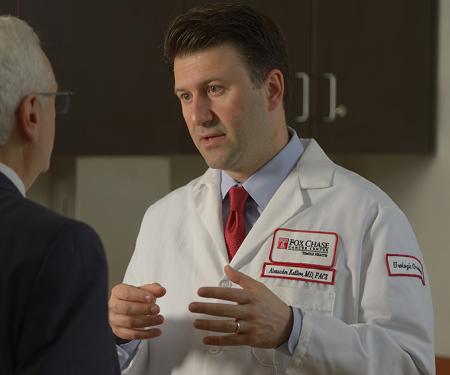Most bladder cancers are treated with some type of surgery to remove the tumor, depending on the depth of invasion by the cancer cells. The stage of bladder cancer dictates the degree of surgery needed to address the cancer.
For superficial bladder cancer (Ta/T1):
- Transurethral resection of bladder tumor (TURBT) is a surgical procedure to remove non-muscle invasive bladder cancers. This procedure usually takes place at the time of diagnosis during the cystoscopy and involves the insertion of a thin telescope (cystoscope) through the urethra. This procedure can be repeated to surgically remove recurring bladder cancer. For some patients, Blue Light Cystoscopy with Cysview (BLCC) may improve detection and more complete removal of early stage bladder cancer.
For bladder cancer involving the muscle layer (T2 or higher):
- Intravesical therapy is cancer treatment that may be placed directly into the bladder through a catheter.
- Immumotherapy is the most common type of intravesical therapy, which boosts the body’s immune system to fight the cancer. BCG (Bacillus Calmetter-Guerin) is often given to patients with early stage non-muscle invasive bladder cancer after a transurethral resection of bladder tumor.
- Other intravesical therapies include additional immunotherapies and chemotherapy.
- Cystectomy is a surgery that treats muscle-invasive bladder cancer by removing all or a portion of the bladder.
- In a radical cystectomy, the entire bladder is removed, as well as nearby lymph nodes and pelvic organs (hysterectomy also performed with women/ prostatectomy also performed with men). This is followed by reconstructive surgery to create a urinary diversion, or a new way for the body to store and release urine. Fox Chase urologic surgeons are adept at both traditional and robot-assisted radical cystectomy techniques.
- Very select patients may be able to have a partial cystectomy, in which only the portion of the bladder affected by cancer is removed and the function of the maintained bladder can be preserved.
- Reconstructive Surgery. Patients who undergo a cystectomy have several options to reroute the flow of urine out of the body. Your surgeon will explain each option to you in detail and help you make an informed decision. There is no single best choice for urinary system reconstruction.
- Ileal conduit, the simplest option, creates an opening (a stoma) in the abdominal wall that allows urine to drain out, typically into a small bag outside the body.
- Continent cutaneous urinary diversion, or Indiana pouch, uses a section of the colon to create an internal pouch that allows urine to collect internally, until it is drained via a catheter that is placed into the pouch by the patient.
- Ileal neobladder aims to replace the bladder by creating a pouch from a piece of the small intestine. The neobladder is attached to the urethra in a similar position to the bladder, closely recreating normal urination.
